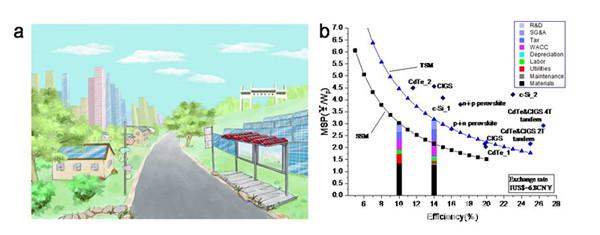Energy & Environmental Science (IF = 30.067), a top international journal in the field of energy, published the latest research results of Min Jie ’s research group of the Advanced Research Institute. This work proposed a new layer-by-layer scraping technology (Layer-by -Layer, LbL), not only makes the film performance higher, but also can be applied to the preparation of large areas of organic photovoltaic devices.
The topic of the thesis is A Universal Layer-by-Layer Solution-Processing Approach for Efficient Non-fullerence Organic Solar Cells ("A Universal Layer-by-Layer Solution-Processing Approach for Efficient Non-fullerence Organic Solar Cells" C8EE02560F "). Wuhan University Advanced Research Institute is the first signed unit / communication unit, and the 2017 graduate students Sun Rui and Guo Jing of the Advanced Research Institute are the co-first authors, and the cooperation instructor Researcher Min Jie is the corresponding author.
Organic solar cells have attracted people's attention because of their unique advantages of low cost, light weight, translucent and flexible devices. In a previous study, Min Jie's group analyzed the cost of industrial application of organic solar cells in Wuhan in detail (Adv. Energy Mater. 2018, 1802521), and compared the cost price of organic solar cells with other new solar cells. The results show that organic solar cells have huge advantages in terms of cost.

Prospect of commercial application of organic solar cells and comparison of efficiency and cost of various photovoltaic cells
At present, the photoelectric conversion efficiency of organic solar cells based on bulk heterojunction structure (BHJ, bulk heterojunction) has exceeded 14%. However, the morphology at the nanoscale of bulk heterojunctions is difficult to control, and it is particularly sensitive to the processing environment and material properties. In order to overcome the shortcomings of heterojunction active layer processing, Min Jie's group successfully prepared vertical phase separation and charge transport by layer-by-layer solution method (LbL, shown in Figure 2) using two different processes: spin coating and blade coating And the active layer structure with high collection efficiency. Compared to the BHJ active layer structure, the LbL active layer structure not only exhibits comparable or even higher photoelectric conversion efficiency, but also shows better device thermal stability. Further, using the developed layer-by-layer blade coating technology, a non-fullerene organic solar cell with an efficiency of more than 10% and an effective area of ​​1.0 cm-2 was successfully prepared. This work provides a new coating technology for large-area preparation of organic solar cells, which has great application prospects.

Layer-by-layer organic solar cell preparation process
This work was supported by the National Natural Science Foundation of China, the Natural Science Foundation of Hubei Province, Wuhan University talent introduction and independent research projects. The photovoltaic materials involved in this research were provided by Academician Li Yongfang of the Chinese Academy of Sciences, Professor Yang Chuluo of Wuhan University and Professor Tang Weihua of Nanjing University of Technology. The grazing incidence wide-angle X-ray scattering topography data was characterized by Dr. Jiao Xuechen of Monash University in Australia. (Correspondent Xie Zhangbin)
BK7 Penta Prisms,pentaprism , penta Prisms ,pentaprism vs pentamirror , pentaprism viewfinder , pentaprism angles
Materials: optical glasses such as flint glass, ultraviolet fused quartz and infrared fused quartz, as well as optical crystal materials such as calcium fluoride (CaF2), germanium (Ge), Zinc selenide (ZnSe) and silicon (Si)
External dimension: 4mm -- 100mm
Angle deviation: 30 seconds to 3 minutes
Surface accuracy: / 10-1
Surface quality: 60/40 Effective diameter: 90%
Plating film: according to customer requirements can be coated
In addition, we have more than a thousand kinds of standard products, and some of the standard products in stock to meet your needs
According to users' requirements, we can design and process various kinds of prisms, such as right-angle prisms, Equilateral Prisms, Dove Prisms, pentagonal prisms, Roof Prisms and so on with different base materials.

Materials: optical glasses such as flint glass, ultraviolet fused quartz and infrared fused quartz, as well as optical crystal materials such as calcium fluoride (CaF2), germanium (Ge), Zinc selenide (ZnSe) and silicon (Si)
External dimension: 4mm -- 100mm
Angle deviation: 30 seconds to 3 minutes
Surface accuracy: / 10-1
Surface quality: 60/40 Effective diameter: 90%
Plating film: according to customer requirements can be coated
In addition, we have more than a thousand kinds of standard products, and some of the standard products in stock to meet your needs
According to users' requirements, we can design and process various kinds of prisms, such as right-angle prisms, equilateral prisms, DOVE prisms, pentagonal prisms, roof prisms and so on with different base materials.
Penta Prisms
Penta Prisms,Convex Lense,Convex Spherical Lens,Optical Glass Windows
Gold Dragon Optics Electronic Technology CO.,Ltd , https://www.golddragon-optics.com
![<?echo $_SERVER['SERVER_NAME'];?>](/template/twentyseventeen/skin/images/header.jpg)